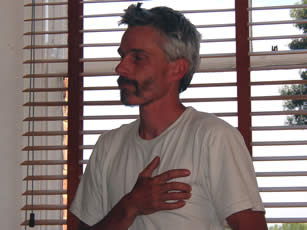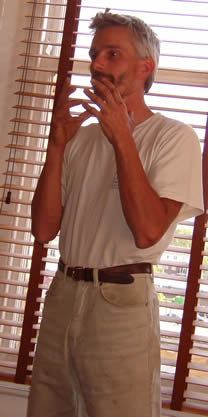
|
Magma:
taking
natural wine to the limit
Frank Cornelissen is a Belgian who has begun a new
winery on the slopes of Mount Etna in Sicily that is one of the most
unique and unusual projects I’ve yet encountered in the world of
wine. He began collecting wines with his father, and the first wines
he bought were a mixed case of 1972 Domaine de la Romanée Conti.
Despite the cost, he was hooked. Since then ‘wine has never left
me’, he says. Later, he became a wine agent, and talking regularly
with winemakers he became interested by the rather philosophical
question of what wine actually is. Over 20 years of tasting, he found
that he liked wines that were an expression of culture, that are more
evolved, and which express the soil more than the fruit. He decided
that he wanted wines with a more natural approach and that he’d like
to make wines without any treatments in the vineyard, winemaking or
bottling. One day at a restaurant in Sicily someone bought out
a sample of a wine from Etna. He
immediately got in his car and drove round to the winery. Liking what
he saw, he rented some vineyards on Etna, and made a wine in some
abandoned sheds. This led to Frank buying an old ungrafted vineyard in
2001, which led to the creation of Magma. Cornelissen’s estate consists of 5.5 hectares on
the north slopes of Mount Etna. Of this, 2.5 hectares are ungrafted
vines grown in the classic free-standing alberello (gobelet) system.
The rest is given over to olive trees, fruit trees and bush. ‘I
strive to abbandon monoculture in order to avoid the classic diseases,
and have already intermixed the existing vineyards with various trees
and plants,’ says Frank. ‘The newly replanted alberello vineyard
was planted directly, with original branches of the pre-phyloxera
vines, thus without the grafted genetically engineered rootstock. I
decided for a low density for the areas standard (approximately 4000
plants/hectare) to give a better ventilation and the ability to
cultivate other plants and vegetables in between the vines.’ The top wine is Magma, wine made from old Nerello
Mascalese vines (50–80 years), from the highest parts of the
vineyard. I’ll let Frank describe the vinification. ‘The wine is
produced in a non-interventionalist way, fermented and aged according
to ancient traditions in terracotta vases of approximately 400 litres
each, buried in the ground in the cellar and fixed with ground
volcanic rock. My aim is to avoid all treatments whatsoever in
vineyard, orchard and surroundings, in which I succeeded in 2001.
Unfortunately I had to treat with Bordelaise mix in 2002 one time on
June 20th which was, given the wet conditions an unbelievable
achievement. [In 2003 another treatment was necessary.] I harvest
relatively late between end of October and early November to obtain
beautifully healthy and ripe grapes, but avoiding overripe grapes. The
yields are about 300 grams per vine, realised early in the growing
season by pruning very short. Every grape bunch is tailored and tails
are cut away as well as unripe berries are delicately picked out of
the bunches... a monk's job! I refuse to add any sulphur dioxide (SO2)
in any aspect of winemaking. I use very long masceration periods until
after the malolactic fermentation, in order not to disturb the
delicate and complex natural fermentation processes. In this way the
grape/wine mass remains unseparated and complete during the entire
transformation process which is important to maintain a cosmic link in
order to extract all possible aromas of soil and area. The separation
of the skins from the wine is done around April, after the wine has
finished the malolactic fermentation.’
Frank continues, ‘Total production was just 1000
bottles in 2001 over one Magma® Rosso and Rosso del Mongibello. There
will be approx. 2000 bt. in 2002 over 3 Magma® Rosso wines from
different vineyards and one Rosso del Contadino (available march
2005). The goal is to arrive at a total of approx. 6000 to 8000
bottles annualy divided over 4 wines: Magma® Rosso as a monovarietal,
single vineyard wine, the Magma® Bianco as a "Jura-style"
oxidized wine, Rosso del Mongibello as a monovarietal, multi-vineyard
wine which depending on our decision may also be a blend of vintages
like the traditional reserva wines of old days and our new Rosso del
Contadino, a multi varietal, multi vineyard wine, made with a lesser
masceration, bottled with the fine lees, a more simple wine with less
territory precision but high drinkability, made with our grapes.’ ‘Maybe you might find my pricing a little awkward
as the difference between the Magma® and Rosso del Mongibello is
enormous. Let me explain to you why. When I calculated the Magma, the
price was really high because of the enormous costs in the vineyard
selecting and reselecting bunches, grapes, cutting the tails, and so
on. I knew that there is always a selection of grapes that isn't the
"ne plus ultra" and so I wanted to make also an assembled
wine with the same philosophy, the Rosso del Mongibello. Magma as top
wine was expensive and thus destined for wealthy people and I felt the
Rosso was also too expensive to be tasted by average people. I didn't
want to make wine only for the economically rich people and so I
lowered the price on the Rosso and raised the price on the Magma to
cover the loss and get the balance. I have now a high-end wine that
reflects territory and I have a wine that remains accessible for
virtually every wine-lover, which is "co-sponsored" by the
Magma lovers. A social price-setting.’ Frank also makes a high-end olive oil and grows two
varieties of wheat, together with other crops in smaller quantities.
‘Wine has become the Hollywood of agriculture’, he says. He uses
the money from his wine to subsidise his cereals. These are my tasting notes from the two wines I
tasted. More details about what goes into them and how they are made
can be found below these notes. ‘Wanky’ or not? To some, this
level of attention to detail may seem utterly self-indulgent and
divorced from the real world. I was expecting the wines to be weird
and oxidized. But they were actually fantastic. Unusual, but
compelling. And I think that the wine world needs people like Frank
Cornelissen to push at the boundaries of what is possible. No, I
don’t expect other producers necessarily to give up using sulphur
dioxide and vineyard treatments. Nonetheless, what he’s doing with
Magma will help others ask deeper questions about what they are doing
with their wines, which can only be a good thing. Rosso del Mongibello Magma Rosso 1 UPDATE (August 2009) - for a more recent write up on Frank's wines, see this piece. The different wines (these are the descriptions
provided by Frank): Magma® rosso Magma® bianco Rosso del Mongibello (nb Mongibello is named
MunJebel from the 2006 vintage) Rosso del Contadino Wines tasted 24 May 2004 aviailability
in the UK: |
 ‘It’s
a bit wanky, isn’t it?’ That was the verdict offered by a
newspaper wine correspondent who’d caught the tail end of a
presentation by Frank Cornelissen (right), who was presenting
his wines in the UK for the first time. Just 515 bottles of the
inagural Magma, his top wine, will be released. The UK allocation is
one case of 9, and each bottle will cost more than £100. Is it wanky,
or is Frank doing something significant and interesting? Read on and
judge for yourself.
‘It’s
a bit wanky, isn’t it?’ That was the verdict offered by a
newspaper wine correspondent who’d caught the tail end of a
presentation by Frank Cornelissen (right), who was presenting
his wines in the UK for the first time. Just 515 bottles of the
inagural Magma, his top wine, will be released. The UK allocation is
one case of 9, and each bottle will cost more than £100. Is it wanky,
or is Frank doing something significant and interesting? Read on and
judge for yourself.  The
use of amphorae is a fascinating practice. Frank says that he traveled
half the world to find the right density of clay. Amphorae allow the
wine to breathe a little, but don’t give the tannins of the wood,
nor do they alter the wines colour. Frank likes this because he
doesn’t want to add anything to the vine. The evaporation rate from
a 400 litre amphora is about the same as from a 2000 or 3000 litre
vat; a 250 litre amphora resembles a 1500 litre vat and a 100 litre
amphora is close to a barrique.
The
use of amphorae is a fascinating practice. Frank says that he traveled
half the world to find the right density of clay. Amphorae allow the
wine to breathe a little, but don’t give the tannins of the wood,
nor do they alter the wines colour. Frank likes this because he
doesn’t want to add anything to the vine. The evaporation rate from
a 400 litre amphora is about the same as from a 2000 or 3000 litre
vat; a 250 litre amphora resembles a 1500 litre vat and a 100 litre
amphora is close to a barrique.